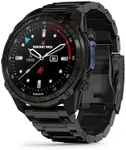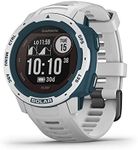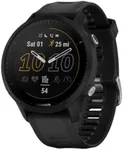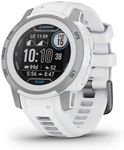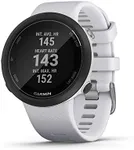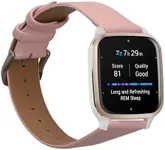Buying Guide for the Best Garmin Swim Watches
Choosing a Garmin swim watch can be a great way to track your swimming workouts, monitor your progress, and stay motivated. When picking the right swim watch, it's important to think about how you swim (in a pool, open water, or both), what kind of data you want to track, and how you plan to use the watch outside of swimming. Understanding the key features will help you find a watch that fits your needs and makes your swimming experience more enjoyable and productive.Water ResistanceWater resistance tells you how well the watch can handle being in water. For swimming, you need a watch that is specifically rated for swimming, usually at least 5 ATM (50 meters) or higher. Watches with lower ratings are only splash-proof and not suitable for swimming. If you swim in pools, 5 ATM is generally enough, but for open water or diving, look for higher ratings. Always check the manufacturer's guidelines to ensure the watch is suitable for your swimming activities.
Swim Tracking FeaturesSwim tracking features refer to the watch's ability to record swim-specific data like lap count, stroke type, distance, pace, and SWOLF (a measure of swimming efficiency). Basic watches may only count laps and time, while more advanced ones can detect different strokes, track rest periods, and provide detailed swim metrics. If you are a casual swimmer, basic tracking might be enough, but if you want to improve your technique or train seriously, look for watches with more advanced swim metrics.
Open Water vs. Pool Swimming SupportSome watches are designed mainly for pool swimming, while others can also track open water swims using GPS. Pool-only watches use sensors to count laps and strokes, but they can't track your route in a lake or ocean. If you swim outdoors, choose a watch with GPS and open water swim mode. If you only swim in pools, a pool-focused watch will be simpler and may suit you better.
Heart Rate MonitoringHeart rate monitoring lets you track your heart rate during swims, which can help you train at the right intensity. Some watches have built-in optical sensors that work underwater, while others require a special chest strap. If you want to monitor your heart rate while swimming, make sure the watch supports underwater heart rate tracking. If heart rate data isn't important to you, this feature may not be necessary.
Battery LifeBattery life determines how long the watch can operate between charges, especially when using swim tracking or GPS. Some watches last for days, while others may need charging more often if you use advanced features. If you swim frequently or go on long open water swims, look for a watch with longer battery life. For occasional or short swims, battery life may be less of a concern.
Comfort and FitComfort and fit are important because you'll be wearing the watch during intense activity and in water. A watch that's too bulky or heavy can be distracting or uncomfortable. Look for a lightweight, slim design with a secure, adjustable strap. If you have a smaller wrist, consider watches designed for a snug fit. Comfort is personal, so try on different styles if possible.
Smart FeaturesSmart features include things like notifications, music controls, and compatibility with fitness apps. Some swim watches offer basic smart features, while others are more like full smartwatches. If you want to receive messages, control music, or sync with your phone, look for a watch with these capabilities. If you only care about swim tracking, you can choose a simpler model.
